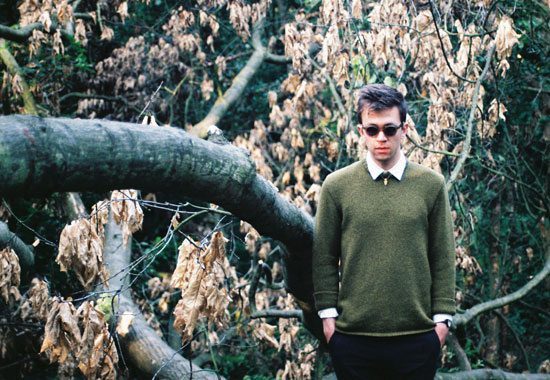Raffertie’s compositional ambitions happen on a grand scale – at times his basslines have at the warping boom of pedal-timpany; at other times they use pitch-bend to underpin the melodies using a non-percussive approach to bass programming.
Choosing a modulated bassline, rather than the staccato drive of a sequence of individual notes, is more akin to a bowed cello than it is to bass guitar or piano. This quasi-orchestral approach to arrangement is Raffertie’s defining characteristic, taking each song as a composition, presumably building each melodic and rhythmic part around a vision of what the track will be, then constructing each voice – the scattering high-hat/snare beats; the insistent pattering tick of a lighter percussive element; the melodic keyboard topline; the glassy shivering synth accents, and that aforementioned undulating bass voice.  It’s certainly a more involved approach to electronic music than the simpler tack of sequencing loops together on a user display and fading the beats and basslines in an out as needed. Which is not to say that he doesn’t use the loops and beats approach anywhere on the EP – Twitch (It Grows and Grows) is saved from being a pastiche of mid-90s GoBang Records hardfloor by its thumping sub-bass bed, but only just.
It’s certainly a more involved approach to electronic music than the simpler tack of sequencing loops together on a user display and fading the beats and basslines in an out as needed. Which is not to say that he doesn’t use the loops and beats approach anywhere on the EP – Twitch (It Grows and Grows) is saved from being a pastiche of mid-90s GoBang Records hardfloor by its thumping sub-bass bed, but only just.
a broken beat and bassline section very close to The Freestylers’ ‘We Rock Hard’
There is a sense of humour on the EP though, evident in the vocal samples used on the eponymous opening track. It lightens the mood on a tune which is otherwise incredibly reminiscent of 808 State’s ‘Olympic’- an onslaught of beats coalescing and separating over the course: cowbells, pattering brushwork, tocking claves, icy synths and a pitch-bending bassline which, if it only had the Roland 808’s trademark squelch, would drop the listener directly into 1990.
Raffertie – ‘Visual Acuity’ (Preview Edit) by Ninja Tune
To be fair, it’s more referential than derivative. The originality lies in the accents and particular tones of the percussive elements, and how they are arranged into a tune which mutates and develops along its length whilst still referencing its own recurring melodic motif. This nodal approach to composition is a mainstay of orchestral works, particularly in the sonata form. The melodic motif constitutes a recurring node which can be altered to an extent (in pitch, tempo or melody), but retains a recognisable pattern. Around that form the musician is free to improvise. As a technique it is latently recognised by anyone familiar with the popular chunks of classical works which soundtrack countless advertisements, sports sequences and motion pictures. Here, applying it to dance/electronica, Raffertie moves beyond the habitual patterns of that genre.
The EP’s second track ‘You Could Be Forgiven For Thinking That’ is an aural gem. A simple, downtempo melody of modal chords forms the basis of the tune. That melody changes little, but is harmonised by distorted vocals, attacked by warping bassbeats, tickled with insistent high-end doubletime percussion, and subjected to a plethora of glitching and compression tricks which should reduce the track to an emotionally vacuous demonstration of computer programming. By virtue of a strong harmonic and melodic vision, Raffertie instead pulls off the difficult trick of imbuing a simple melody with intense dynamics. It would be easy to listen to the tune and assume it was little more than a Boards of Canada remix, but it is much more interesting than that, with the sequenced percussion and production techniques seamlessly integrated into the tune as bona fide compositional elements, rather than as bolted-on post-processing quirks. Slick stuff.
Raffertie instead pulls off the difficult trick of imbuing a simple melody with intense dynamics.
‘Mimetic’ closes the EP with something in a more traditional dance music vein. Rejecting the factionalism which divides dance music as routinely as it unites, the track brings elements of Berlin minimalism, Ibiza rave and oldskool breakbeat together. Opening with florid Sven Vath-style synthwash, moving into a broken beat and bassline section very close to The Freestylers’ ‘We Rock Hard’, and then gathering them all together around a sultry vocal sample – the tune creaks along slightly self-consciously.
For those who see Ibiza as a dusty gathering of fortysomething crinklies recreating dance music’s own Hotel California, ‘Mimetic’ may just soften such harsh judgements, or perhaps not. Either way, the final two tracks on the EP wear the influences of three decades of dance music more obviously than the opening pair, ‘Mimetic’ especially so. What it does lift successfully from its influences, mainly through the vocal sample, is the sweet tension of a dancefloor banger. Dubstep, glitch, LA Beats etc., all are adept at creating the transcendent alpha-waveriding catatonia for which they are so fiercely loved – but that sweet moment of tension before the bass drops back in – that’s an Ibiza thing. Kudos to Raffertie for shoehorning it into the tune. Further kudos to the EP as a whole, a revision and extension of numerous dance music tributaries, with some heavyweight compositional ambition to boot.
Raffertie – Visual Acuity EP is Released August 29th July on Ninja Tune Records
Image by Megan Sharp

An observer first and foremost, Sean Keenan takes what he sees and forges words from the pictures. Media, critique, exuberant analysis and occasional remorse.















